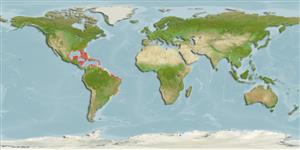>
Gobiiformes (Gobies) >
Gobiidae (Gobies) > Gobiinae
Etymology: Coryphopterus: Greek, koryphe = summit + Greek, pteron = fin, wing (Ref. 45335).
More on author: Gill.
Environment: milieu / Klimaatzone / Diepte / distribution range
Ecologie
marien rifbewoner; diepte 2 - 45 m (Ref. 9710). Tropical; 37°N - 33°S
Western Atlantic: North Carolina, USA and Bermuda to Santa Catarina, Brazil (Ref. 57756); throughout the Caribbean Sea.
Grootte / Gewicht / Leeftijd
Maturiteit: Lm ? range ? - ? cm
Max length : 8.0 cm TL mannelijk / geslacht onbekend; (Ref. 9710)
Dorsale stekels (totaal) : 6; Dorsale zachte stralen (totaal) : 10; Anale stekels: 1; Anale zachte stralen: 10; Wervels: 26. With black spot on side of head above gill cover (Ref. 26938). Individuals from white sand bottom and clear water are pale with two rows of faint yellow spots on side of body; a horizontal orange streak extending posteriorly from middle of eye to above pectoral fin; a row of dusky spots at base of dorsal fins. Individuals from darker bottom and more turbid water are more darkly pigmented; there are 2 rows of dark spots on side of body and one mid-dorsally, fins dusky (Ref. 13442).
Body shape (shape guide): elongated.
Inhabits clear white sandy areas near deep reefs and grassy and rocky areas. Burrows in the sand and the male guards the eggs (Ref. 5521). The Bridled goby, which has X-shaped marks and spots, occurs in both clear and more murky inshore waters, while the paler, very similar Sand goby, Coryphopterus tortugae [= Coryphopterus glaucofraenum], occurs over white sand (Ref. 26938).
Levenscyclus en paargedrag
Maturiteit | Voortplanting | Paaien | Eieren | Fecunditeit | Larven
Oviparous, demersal spawner (Ref. 101194). Both male and female spawn with many individuals in small contiguous territories (Ref. 240).
Robins, C.R. and G.C. Ray, 1986. A field guide to Atlantic coast fishes of North America. Houghton Mifflin Company, Boston, U.S.A. 354 p. (Ref. 7251)
Status op de Rode Lijst van het IUCN (Ref. 130435: Version 2025-1)
Gevaar voor de mens
Harmless
Gebruik door de mens
Visserij: commercieel; Aquarium: Commercieel
Tools
Speciale rapporten
Download XML
Internetbronnen
Estimates based on models
Preferred temperature (Ref.
123201): 24.4 - 28, mean 27 °C (based on 254 cells).
Fylogenetische diversiteitsindex (Ref.
82804): PD
50 = 0.5001 [Uniqueness, from 0.5 = low to 2.0 = high].
Bayesian length-weight: a=0.00759 (0.00466 - 0.01235), b=3.04 (2.91 - 3.17), in cm total length, based on LWR estimates for this species & (Sub)family-body (Ref.
93245).
Trofisch niveau (Ref.
69278): 2.7 ±0.4 se; based on diet studies.
Weerstandsvermogen (Ref.
120179): Hoog, minimale populatieverdubbelingstijd minder dan 15 maanden (Preliminary K or Fecundity.).
Fishing Vulnerability (Ref.
59153): Low vulnerability (10 of 100).
🛈
Nutrients (Ref.
124155): Calcium = 166 [74, 326] mg/100g; Iron = 0.879 [0.427, 1.743] mg/100g; Protein = 17.7 [15.7, 19.4] %; Omega3 = 0.0941 [, ] g/100g; Selenium = 28.8 [13.0, 66.9] μg/100g; VitaminA = 115 [28, 450] μg/100g; Zinc = 2.44 [1.56, 3.66] mg/100g (wet weight);
